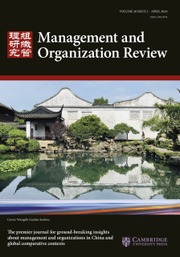Crossref Citations
This article has been cited by the following publications. This list is generated based on data provided by
Crossref.
Mok, Aurelia
and
Morris, Michael W.
2010.
Asian-Americans' Creative Styles in Asian and American Situations: Assimilative and Contrastive Responses as a Function of Bicultural Identity Integration.
Management and Organization Review,
Vol. 6,
Issue. 3,
p.
371.
Hempel, Paul S.
and
Sue-Chan, Christina
2010.
Culture and the Assessment of Creativity.
Management and Organization Review,
Vol. 6,
Issue. 3,
p.
415.
Erez, Miriam
and
Nouri, Rikki
2010.
Creativity: The Influence of Cultural, Social, and Work Contexts.
Management and Organization Review,
Vol. 6,
Issue. 3,
p.
351.
Morris, Michael W.
and
Leung, Kwok
2010.
Creativity East and West: Perspectives and Parallels.
Management and Organization Review,
Vol. 6,
Issue. 3,
p.
313.
Chiu, Chi-yue
and
Kwan, Letty Y-Y.
2010.
Culture and Creativity: A Process Model.
Management and Organization Review,
Vol. 6,
Issue. 3,
p.
447.
De Dreu, Carsten K. W.
2010.
Human Creativity: Reflections on the Role of Culture.
Management and Organization Review,
Vol. 6,
Issue. 3,
p.
437.
Zhang, Ann Yan
Tsui, Anne S.
and
Wang, Duan Xu
2011.
Leadership behaviors and group creativity in Chinese organizations: The role of group processes.
The Leadership Quarterly,
Vol. 22,
Issue. 5,
p.
851.
Li, Peter Ping
Bai, Yuntao
and
Xi, Youmin
2012.
The Contextual Antecedents of Organizational Trust: A Multidimensional Cross-level Analysis.
Management and Organization Review,
Vol. 8,
Issue. 2,
p.
371.
Vu, Dang Le Nguyen
Napier, Nancy K.
and
Vuong, Hoang Quan
2012.
It Takes Two to Tango: Entrepreneurship and Creativity in Troubled Times – Vietnam 2012.
SSRN Electronic Journal,
Sanandrés Domínguez, Elena
2013.
Work stressors and creativity.
M@n@gement,
Vol. 16,
Issue. 4,
p.
479.
Dougherty, Deborah
Bertels, Heidi
Chung, Ken
Dunne, Danielle D.
and
Kraemer, Justin
2013.
Whose Time Is It? Understanding Clock-time Pacing and Event-time Pacing in Complex Innovations.
Management and Organization Review,
Vol. 9,
Issue. 2,
p.
233.
Wang, Chung-Jen
Tsai, Huei-Ting
and
Tsai, Ming-Tien
2014.
Linking transformational leadership and employee creativity in the hospitality industry: The influences of creative role identity, creative self-efficacy, and job complexity.
Tourism Management,
Vol. 40,
Issue. ,
p.
79.
Anderson, Neil
Potočnik, Kristina
and
Zhou, Jing
2014.
Innovation and Creativity in Organizations.
Journal of Management,
Vol. 40,
Issue. 5,
p.
1297.
Zhang, Xiaomeng
and
Zhou, Jing
2014.
Empowering leadership, uncertainty avoidance, trust, and employee creativity: Interaction effects and a mediating mechanism.
Organizational Behavior and Human Decision Processes,
Vol. 124,
Issue. 2,
p.
150.
Büyükbalcı, Pınar
Bal, Yasemin
Ertemsir, Esin
and
Turan, Sevgin Batuk
2014.
Chaos, Complexity and Leadership 2012.
p.
183.
Hon, Alice H.Y.
and
Lu, Lin
2015.
Are we paid to be creative? The effect of compensation gap on creativity in an expatriate context.
Journal of World Business,
Vol. 50,
Issue. 1,
p.
159.
Chen, Tingting
Leung, Kwok
Li, Fuli
and
Ou, Zhanying
2015.
Interpersonal harmony and creativity in China.
Journal of Organizational Behavior,
Vol. 36,
Issue. 5,
p.
648.
Zhang, Yong
Long, Lirong
Wu, Tsung‐yu
and
Huang, Xu
2015.
When is pay for performance related to employee creativity in the Chinese context? The role of guanxi HRM practice, trust in management, and intrinsic motivation.
Journal of Organizational Behavior,
Vol. 36,
Issue. 5,
p.
698.
Ma, Choi‐Chi Evelene
and
Rapee, Ronald M.
2015.
Differences in Mathematical Performance, Creativity Potential, and Need for Cognitive Closure between Chinese and Australian Students.
The Journal of Creative Behavior,
Vol. 49,
Issue. 4,
p.
295.
Poethke, Ute
and
Kryshko, Olena
2015.
Innovationsförderndes Human Resource Management.
p.
101.


